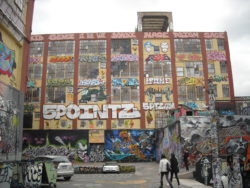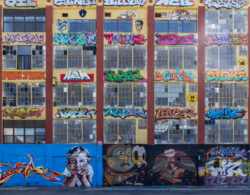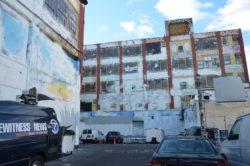 Graffiti has become much more than spray-painted tags and quickly disappearing pieces on train cars and underpasses. In some quarters it is now high art. Highly prized are works by Shepard Fairey, the artist behind the “Hope” poster Fairey made for Barack Obama’s presidential campaign, Jean-Michel Basquiat, who began as a graffiti artist and whose works today command huge prices, and Banksy, whose street works are carefully preserved. These dramatic changes in the nature and importance of graffiti have created major shifts in and problems for artists and intellectual property law, as well as for property owners. The tensions are very evident in the most recent judicial opinions in the dispute between artists who used to paint at 5Pointz in Long Island City in Queens and the developers who destroyed the highly decorated buildings for construction of two large apartment buildings which are now under construction.
Graffiti has become much more than spray-painted tags and quickly disappearing pieces on train cars and underpasses. In some quarters it is now high art. Highly prized are works by Shepard Fairey, the artist behind the “Hope” poster Fairey made for Barack Obama’s presidential campaign, Jean-Michel Basquiat, who began as a graffiti artist and whose works today command huge prices, and Banksy, whose street works are carefully preserved. These dramatic changes in the nature and importance of graffiti have created major shifts in and problems for artists and intellectual property law, as well as for property owners. The tensions are very evident in the most recent judicial opinions in the dispute between artists who used to paint at 5Pointz in Long Island City in Queens and the developers who destroyed the highly decorated buildings for construction of two large apartment buildings which are now under construction.
The 5Pointz site in Long Island City, a largely empty five-story factory building during the early 1990s, became covered with graffiti as the decade progressed. Gerald Wolkoff, the primary owner of the complex, allowed the graffiti artists to paint at the site beginning in 1993 and to rent space inside for studios. In order to obtain greater management of the situation Wolkoff agreed in 2002 to allow Jonathan Cohen, one of the artists working at 5Pointz, to organize, control, and curate the creative endeavors. Cohen established rules barring painting without his permission and requiring Cohen’s consent before onsite picture taking or filming could occur. After an interior stair collapse in 2009 the interior studio spaces were emptied.
Under Cohen’s watchful eye, the area became an internationally recognized graffiti center. It was that fame that led to litigation when the owner revealed plans to demolish the old commercial buildings along with its graffiti covered walls. Many—both artists and art lovers—mourned destruction of the site.
Graffiti as art
The notion that writing tags, posting decals, or making other art works in outdoor spaces would grow into a major art form of “recognized stature”—in the language of the federal Visual Artists Rights Act—was certainly far from virtually everyone’s mind half a century ago. While all art aficionados know that artistic tastes and movements continually change—sometimes in radical ways—few could have imagined that street art once routinely described as vandalism would emerge as heralded creativity. That shift now raises new questions about both the legal status of graffiti, the continued vitality of the art form, and the impact on property owners who allow artists to paint on their walls.
Until recently graffiti was almost always painted over. Virtually no one assumed it was or should be permanent. Indeed its temporary quality was and is a deeply engrained part of its original aesthetic. Doing graffiti was an act of rebellion, a rejection of the fetishizing of “great” art, and a celebration of the sometimes hasty act of creation. Since much of it was illegal and therefore risky to make, the expectation that it would be painted over or washed off was an accepted part of the culture. With the increasing fame and artistic quality of pieces at 5Pointz and other locations there is a growing desire even among those who previously scorned the work to preserve it. In addition, entrepreneurs and developers now see graffiti, if done “right,” as a spur to economic development and new artistic movements.
In certain neighborhoods commercial establishments, businesses, and warehouse owners now encourage artists to paint large, complex pieces on their walls to attract artists to the community. They hope the arrival of creative souls will encourage neighbors, developers, and entrepreneurs to rehabilitate rundown buildings as loft, studio, and gallery spaces. Bushwick in Brooklyn is a prime present-day example of the trend. The Bushwick Collective is now a vibrant organization working with neighborhood businesses and residents to bring in artists from all over the world to create major pieces. Some of the artists working in Bushwick began painting in the neighborhood after the famous graffiti zone at 5Pointz was demolished in 2014.
Graffiti is becoming part of the monetized art world. That shift undermines much of the basic aesthetic core of “traditional” graffiti. Rather than celebrating an act of rebellion, parts of the street art world are gradually becoming subject to the same monetized instincts that now govern major art museums and galleries. This hardly is the world rebellious painters envisioned when they put tags on buildings and mailboxes and made large pieces on subway cars, tunnels, and underpasses during the 1960s and 1970s. The artists working at 5Pointz before its demolition were very much aware of the cultural shifts and conflicts. Some of them have rued loss of the risk-taking camaraderie common to the early years of street painting, while welcoming the ability to work in unhurried ways on large wall pieces and using their creations as entrées into the money-making world.

The Legal Environment
Two legal regimes are potentially important in the street art world—copyright law and historic preservation. American copyright law provides a set of protections for “pictorial, graphic, and sculptural” works, including paintings on any surface—the rights not be copied, distributed in plagiarized versions, or reused without the permission of the artist or the owner of the intellectual property interests in the art. If, for example, a shoe company uses a photograph of a piece of street art in advertisements, litigation may be brought to stop use of the ad and obtain damages from the party wrongfully using the image.
Until 1990, however, there was no provision in the copyright statute barring the owner of a copy of a work of art from mutilating or destroying it. In contrast to virtually every other county in the world, an American was free to rip apart a painting hanging on her wall. Congress filled that gap in 1990 when Congress adopted the Visual Artists Rights Act providing some protections against destructive behavior in cases involving a “work of visual art”—defined in the act to include unique two or three dimensional works, and prints and photographs issued in small editions that are signed and numbered by the artist. Graffiti is included in this visual art category. The surface an artist paints on makes no difference. Canvas, paper, leather, a human body, or a masonry wall all work.
The Visual Artists Rights Act, among other topics, bars the owner of a work of visual art from mutilating it in a way that “would be prejudicial to his or her honor or reputation” or from destroying a work of “recognized stature.” These provisions present difficult questions when an art work is in or on a building. What happens when the building is remodeled or torn down? The statute stipulates that the protections against mutilation or destruction operate unless the artist and the owner of the property sign a written statement acknowledging that the art may be subject to damage if the owner decides to alter the building.
There were several reasons why Congress adopted the Visual Artists Rights Act in the form enacted in 1990. First, the United States was required by the major international copyright arrangement—the Berne Convention for the Protection of Literary and Artistic Works—to maintain a system of “moral rights” protection giving artists some control over the labeling, treatment, mutilation, or destruction of their work. As international trade in intellectual property increased in the second half of the twentieth century, pressure grew on the United States to join the Berne Convention. Second, virtually every other country in the world maintained a system of moral rights. United States law was dramatically out of step and criticism of our stance was mounting. Finally, there were two solid policy reasons for adopting moral rights protections. Allowing the mislabeling, mutilation, or destruction of a work of art strikes many as a violation of basic notions of respect for the creative talents of artists. In addition, preserving important works of art from mutilation or destruction guarantees that future generations will be able to see and learn from our predecessors.
Moral rights law, therefore, serves in part as a structure of historic preservation—the same instinct behind traditional historic preservation legislation. In New York City, of course, there are many neighborhoods, building exteriors, and interior spaces that may only be modified or destroyed in quite limited circumstances. Grand Central Terminal is one of the most famous such structures. And its magnificent central interior space also is protected. Any building in the city with important features more than thirty years old may be subject to designation as historic. That includes structures or interiors with important artistic works. Two recent disputes about valuable artistic works involved the interior space and art work at the Four Seasons Restaurant in the Seagram Building and the Art Wall on the exterior of 599 Broadway at Houston Street. The latter case emphasizes that exterior art work applied to a building is subject to the preservation laws.

Photo Credit: Hans Von Rittern
The 5Pointz Litigation
In 2013 the owner of the 5Pointz factory building filed an application with New York City to allow construction of a large apartment complex to include about 1000 units of housing and over 200 subsidized units. By October 2013 the City Plan Commission and the City Council had approved plans for the project. Jonathan Cohen and other artists with work on the walls of 5Pointz petitioned to have the 5Pointz complex designated as an historic site by the Landmarks Preservation Commission of New York City. The landmark effort quickly failed because the aesthetic features making the buildings historically important were less than thirty years old. The moral right claim, however, was and is much more powerful.
On October 10, 2013 Cohen and sixteen other painters sued Gerald Wolkoff and the business organization owners of 5Pointz claiming that the eminent demolition of the complex would violate the Visual Artists Rights Act. They sought preliminary and permanent injunctive relief, along with a temporary restraining order, to prevent the owner from mutilating or destroying their graffiti and from frustrating their ability to exploit their copyright interests in the art.
A preliminary injunction hearing was held on November 6-8, 2013 before Judge Frederic Block of the United States District Court for the Eastern District of New York. Judge Block refused to issue a preliminary injunction, concluding that damage relief under federal copyright law was adequate given the temporary nature of graffiti and the knowledge of the 5Pointz artists that the buildings were long scheduled for demolition. Cohen v. G&M Realty, L.P., 988 F.Supp.2d 212 (E.D.N.Y. 2013). The correctness of that result is subject to dispute. Wolkoff, Cohen, and the other artists never signed an acknowledgment, as required by the Visual Artists Rights Act, that demolition or work on the building might endanger the visual art painted on the exterior. And the 5Pointz site was internationally recognized as a major center of important work—probably fulfilling the additional requirement that works of recognized stature gain protection from demolition under the legislation. The court, however, concluded that the value of the project to the developer and the City outweighed the value of the art and declined to bar demolition.
One week after Judge Block refused to grant relief, Wolkoff arranged for workers on lifts to spray paint over most of the hundreds of graffiti pieces at 5Pointz, effectively mooting the possibility of appealing the injunction issue. It was a totally unexpected, and to the artists, deeply insulting, action. Even the court rued the action when it issued its written opinion several weeks after orally declining to enjoin demolition of 5Pointz.
The graffiti artists then amended their pleadings to firm up their claims for damages, adding allegations supporting the award of enhanced damages for willful and malicious violations of copyright law. Since the market for graffiti in place on a building is unlikely to exist, the plaintiffs in the 5Pointz litigation will probably pursue relief under a provision in the copyright law allowing courts to award damages up to $30,000 per violation rather than to award actual damages or require payment of any profits attributable to an infringement. Since damages in the case of destruction of graffiti in place probably are not ascertainable, the statutory damage alternative is very attractive. In addition, the statute has a provision allowing for the assessment of damages in an amount up to $150,000 per violation for willful acts. This latter provision may come into play because of the unexpected whitewashing of the graffiti shortly after the injunction hearing concluded.
The case came back before Judge Block in March 2017 when both sides brought summary judgment motions. Those motions were denied and the court set the case for trial on October 10, 2017 on whether fifty-one graffiti works were of recognized stature and, if so, what damages should be awarded for Wolkoff’s destruction of the works.
In short, the story is still unfolding—providing graphic evidence of both the changing nature of graffiti and the risks for building owners seeking to entice artists to work in their neighborhoods.
Conclusion
Several important consequences flow from the 5Pointz litigation for both artists and for building owners. First, shifts in attitudes about the importance and impact of street art create new and different challenges for the artists themselves. While there is still the danger of arrest for painting on illegal spaces, the growing acceptance of the genre means that some one-time rebellious painters must find ways to adapt to the stresses and pressures of a “big-time” art world. Some, like Shepard Fairey, find ways to successfully make the transition. Others, like Jean-Michel Basquiat, succeed mightily as artists but succumb to the pressures of the changes in their lives. And, of course, these newly famous street artists will need to seek the help of lawyers and others to manage their growing money-making potential.
Second, cities like New York with large repositories of important street art, may want to reconsider the sorts of buildings they attempt to preserve as historic. New York’s requirement that important features of a building be at least thirty years old before qualifying for designation is certainly understandable. Fashions come and go. There is a risk in permanently limiting alteration of a building before we are sure of its value. But aesthetic changes now come and go with great rapidity. So do city landscapes. It is difficult to know whether something made today will end up being worth preserving. But that also creates a risk that an important site will be lost before it can be saved thirty years later. Perhaps New York should consider a new preservation category allowing for the preservation of buildings and interiors of especially high merit before they are thirty years old with a condition that their designation must be carefully reviewed when their age reaches that magic number.
Finally, artists are not the only parties that need to respond to the changing attitudes about graffiti. Building owners also must adapt. While it very understandable that they wish to use artistic endeavors in an effort to improve the quality of life in the areas where they own property, they too must absorb the copyright lessons of 5Pointz. They too must bring in the lawyers to write waiver documents if they wish to avoid the pitfalls, and potentially large damage awards, now facing the owner of 5Pointz.
By: Richard Chused, Professor of Law at New York Law School.

